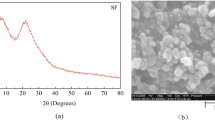Abstract
An accelerated laboratory method (saturated ammonium nitrate solution immersion method) was used to analyze the degradation of cement decalcification process. By studying the changes of intensity, volume, elastic modulus, quality, pH value, the Ca/Si, and mineral phase, it could be found that the first cement decalcification degradation process was the decalcification of calcium hydroxide, and then CSH gel, AFm, etc. The secondary ettringite deposition happened and the decalcification degradation depth was proportional to the square root of time. Moreover, the corresponding strength of cement would be gradually reduced, cement rock volume shrinkage occurred, pH values decreased, the surface elastic modulus decreased down to a certain level, and slightly changed and the Ca/Si was 3.1 from the beginning and lasted down to 1.3.
Similar content being viewed by others
References
Yokozeki K, Watanabe K, Sakata N, et al. Modeling of Leaching from Cementitious Materials Used in Underground Environment[J]. Applied Clay Science, 2004, 26: 293–308
Semra C, Sermin E, Osman NE, et al. Assessment of Leaching Characteristics of Heavy Metals from Industrial Leach Waste[J]. International Journal of Mineral Processing, 2013, 123: 165–171
Nguyen VH, Colina H. Chemo-mechanical Coupling Behavior of Leached Concrete Part I: Experiment Results[J]. Nuclear Engineering and Design, 2007(237): 2 083–2 089
Torrenti JM, Nguyen VH. Coupling between Leaching and Creep of Concrete[J]. Cement and Concrete Research, 2008(28): 816–821
Xie SY, Shao JF, Xu WY. Influences of Chemical Degradation on Mechanical Behavior of a Limestone[J]. International Journal of Rock Mechanics and Mining Science, 2011 (48): 741–747
Yurtdas I, Xie SY, Burlion N, et al. Influence of Chemical Degradation on Mechanical Behavior of a Petroleum Cement Paste[J]. Cement and Concrete Research, 2011(41): 412–421
Xie SY, Shao JF, Burlion N. Experimental Study of Mechanical Behavior of Cement Paste under Compressive Stress and Chemical Degradation[J]. Cement and Concrete Research, 2008(38):1416–1423
Kuhl D, Bangert F, Mescheke G. Coupled Chemo-mechanical Deterioration of Cementitious Materials, Part II: Numerical Methods and Simulations[J]. International Journal of Solids and Structures, 2004(41): 41–67
Nakarai K, Ishida T, Maekawa K. Modeling of Calcium Leaching from Cement Hydrates Coupled with Micro-pore Formation[J]. Journal of Advanced Concrete Technology, 2006, 4(3): 395–407
Kamail S, Moranville M, Leclercq S. Material and Environmental Parameter Effects on the Leaching of Cement Pastes: Experiments and Modelling[J]. Cement and Concrete Research, 2008, 38(4):575–585
Wolfram M, Robin EB, Detlef H. Effect of Carbonation, Chloride and External Sulphates on the Leaching Behavior of Major and Trace Elements from Concrete[J]. Cement and Concrete Composites, 2012, 34: 618–626
Matte V. Durability of Reactive Powder Composites: Influence of Silica Fume on the Leaching Properties of Very Low Water/Binder Pastes [J]. Cement and Concrete Composites, 1999, 21: 1–9
Hiroshi Saito. Leaching Tests on Different Mortars Using Accelerated Electrochemical Method [J]. Cement and Concrete Research, 2000, 30: 1 815–1 825
Engelsen CJ, van der Sloot HA, Grethe W, et al. Leaching Characterization and Geochemical Modelling of Minor and Trace Elements Released from Recycled Concrete Aggregates[J]. Cement and Concrete Research, 2000, 40: 1 639–1 649
Chen JJ. Decalcification Shrinkage of Cement Paste[J]. Cement and Concrete Research, 2006, 36: 801–809
Author information
Authors and Affiliations
Corresponding author
Additional information
Funded by the Natural Science Foundation of Ministry of Housing and Urban-Rural Development of the People’s Republic of China(No. 2009-K4-27)
Rights and permissions
About this article
Cite this article
Yu, H., Yang, J. & Rong, H. Research on decalcification degradation process of cement stone. J. Wuhan Univ. Technol.-Mat. Sci. Edit. 30, 369–374 (2015). https://doi.org/10.1007/s11595-015-1154-1
Received:
Accepted:
Published:
Issue Date:
DOI: https://doi.org/10.1007/s11595-015-1154-1




